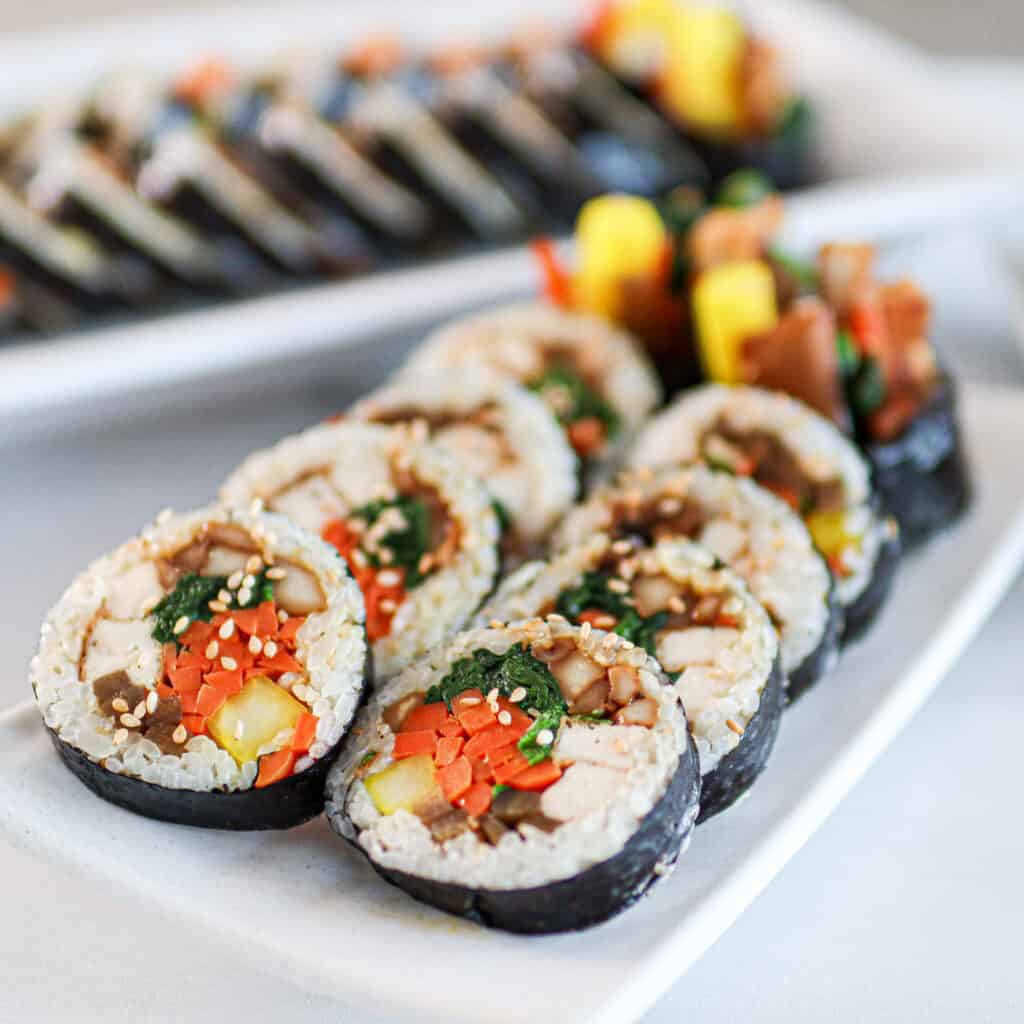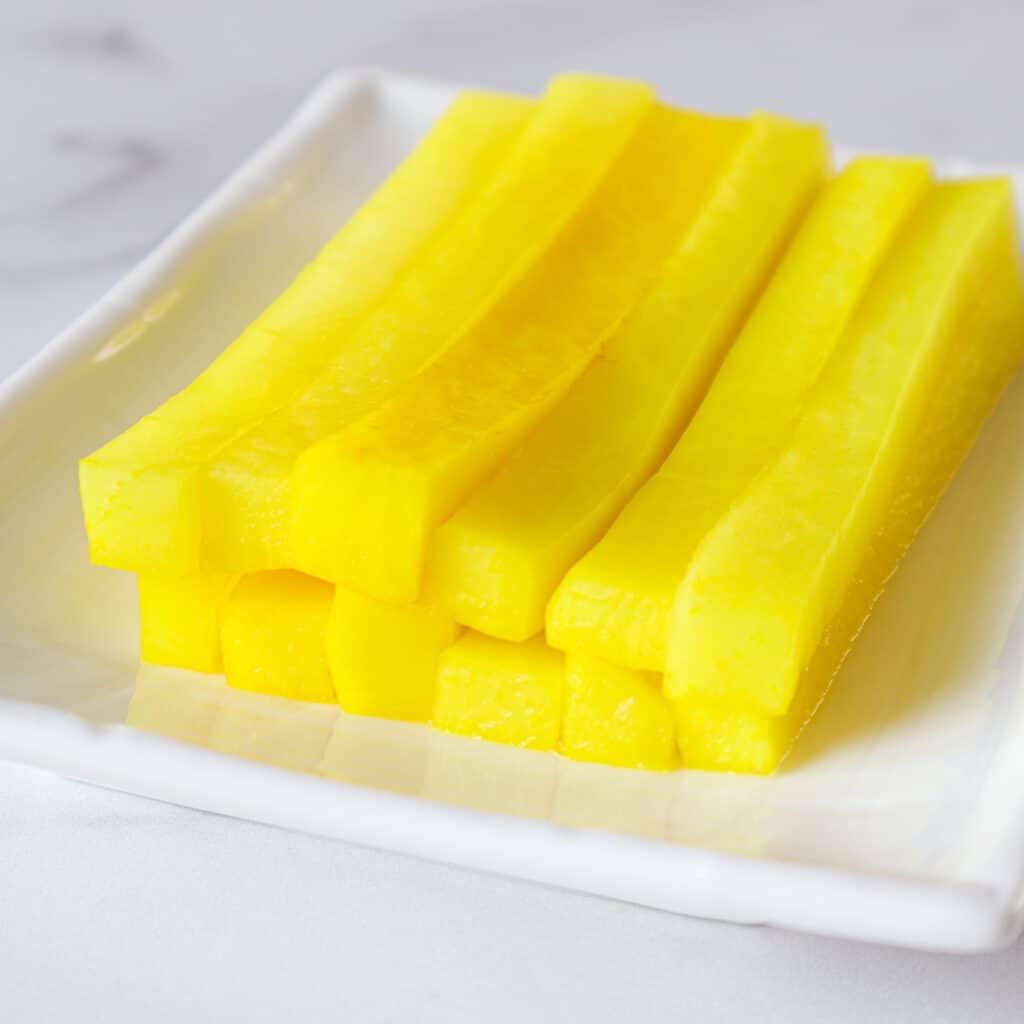
Vegan kimbap (or gimbap) is not so easy to find at the store or at restaurants. It’s almost always filled with some sort of meat and/or fish products.
Before I developed this recipe, I went years without eating kimbap because it wasn’t readily available. So this recipe was the answer to my prayers of being able to enjoy this nostalgic dish again. I’m happy to have kimbap back in my life.
I made so many of these rolls while recipe testing and distributed them to my Korean friends and their response was, “This kimbap is legit! It’s the real deal.” I agree with them 100%. It’s a recipe that both vegans and non-vegans can enjoy because it’s packed with flavour.

Feel free to mix and match the variety of filling ingredients from this recipe. You don’t have to make all of the fillings. If you want to make this recipe super simple, I would recommend trying out a combination of carrots, spinach, bulgogi mushrooms, and danmuji. It will still be packed with flavour and also look beautiful with the mixture of colors.

Here’s a link to my homemade danmuji (pickled Korean daikon) recipe, in case you want to be extra like me and make your own danmuji. You can also use store bought.
TRADITIONAL VEGAN KIMBAP
Ingredients
COOKING RICE FROM DRY
- 2 cups 400g short grain white rice or sushi rice, rinsed thoroughly (until water runs clear, about 5-6 times)
- 2 cups water
SEASONING THE RICE FOR KIMBAP
- 4 cups cooked rice
- 2 teaspoons roasted sesame seeds
- 2 teaspoons roasted sesame oil
- ½ – 1 teaspoon salt, to taste
BRAISED BURDOCK
- 2 cups (460g) water
- ¼ cup (50g) organic cane sugar
- 6 tablespoons (90g) tamari or soy sauce
- 540 g or 2 large burdock roots, peeled & cut into thin strips
- 2 teaspoons roasted sesame oil
- 2 teaspoons roasted sesame seeds
CARROTS
- 600 g or 4 medium carrots peeled & julienned
- 2 teaspoons neutral oil
- ¼ teaspoon salt, to taste
- ¼ teaspoon black pepper, to taste
TOFU
- 396 g 14oz firm tofu, cut into planks
- 3-4 tablespoons neutral oil
- ½ teaspoon salt, to taste
- ½ teaspoon black pepper, to taste
SPINACH
- 450 g or 2 bunches spinach, washed
- ¼ teaspoon salt, to taste
- 1 teaspoon roasted sesame oil
- ½ teaspoon roasted sesame seeds
BULGOGI MUSHROOMS
- 440 g or 4 large king oyster mushrooms, trim off ends & cut into strips
- 3-4 tablespoons neutral oil
- 3 tablespoons tamari or soy sauce
- 2 tablespoons organic cane sugar
- 1 tablespoon roasted sesame oil
- 1 teaspoon roasted sesame seeds
- ¼ teaspoon black pepper
SUSHI NORI SHEETS
DANMUJI (STORE BOUGHT OR USE MY HOMEMADE DANMUJI RECIPE)
Instructions
COOKING RICE FROM DRY – STOVE TOP METHOD
- Add 2 cups rice and 2 cups water in a pot (make sure that the pot is 3X larger in volume than how much dry rice you’re using because the rice will expand). Bring to a boil, then lower the heat to a simmer, put a lid on, and cook for about 15 minutes. Then turn off the heat. Don’t open the lid yet. Allow the rice to steam for 10 minutes with the heat off. Then open the lid and fluff the rice with a fork or rice paddle.
COOKING RICE FROM DRY – RICE COOKER METHOD
- Add 2 cups rice and 2 cups water into the rice cooker. Adjust the rice cooker setting for white rice and turn on. Once the rice cooker lets you know that your rice is done, fluff the rice with a rice paddle.
SEASONING THE RICE FOR KIMBAP
- Place cooked rice, sesame seeds, sesame oil, and salt into a large bowl, and mix thoroughly with a rice paddle or spatula. Cover with a damp kitchen towel so that the rice doesn’t dry out while you roll the kimbap.
BRAISED BURDOCK
- In a medium pot, mix water, sugar, and tamari. Add cut burdock root into the pot. Bring to a boil, lower the heat to about a medium. Simmer without the lid until all the liquid is absorbed, stirring occasionally, about 30 minutes. After all the liquid is gone, turn off the heat and stir in sesame oil and sesame seeds. Set aside.
CARROTS
- In a large pan, add oil, then sauté carrots until lightly cooked. Season with salt and pepper to taste. Remove from the pan, and set aside.
TOFU
- In a large pan, heat oil, add tofu and pan fry both sides until golden. Season with salt and pepper to taste. Remove from the pan, let it cool, then cut into strips. Set aside.
SPINACH
- In a large pan, sauté spinach lightly, until barely wilted. Remove from the pan. When it’s cool enough to handle, squeeze out all the excess water from the spinach. Place spinach in a bowl and season with salt, sesame oil, and sesame seeds. Set aside.
BULGOGI MUSHROOMS
- In a large pan, heat oil, add mushrooms and sauté until golden.
- Once the mushrooms are golden brown around its edges, add tamari (or soy sauce), sugar, sesame oil, sesame seeds and black pepper. Sauté until this marinade gets absorbed into the mushrooms, slightly thickens, and creates a glaze on them. Be careful not to burn the sauce. Remove from pan, and set aside.
ROLLING THE KIMBAP
- Place a nori sheet shiny side down on a sushi rolling mat. Add about 3/4 cup of rice and spread evenly onto the nori sheet, leaving about 1 inch of space at the top. You can wet your fingertips with a little bit of water to prevent the rice from sticking to your hands.
- Add a combination of filling ingredients of choice. Be mindful of flavour balance and avoid overstuffing your kimbap because then it will be difficult to roll. Then roll your kimbap; rolling it tight as possible.
- Place kimbap roll seam side down and roll as many kimbaps as you'd like. The moisture from the fillings will naturally be able to seal your nori. If it doesn't, you can always use a little water to seal it shut.
- Apply a thin coat of sesame oil all around the outside of your kimbap, then cut your kimbap into 8-10 pieces, using a sharp knife.

Hi, thank you for sharing the recipe! I’ve been wandering the internet cluelessly trying to find out what the brown strips in the vegetable kimbap I bought are! After looking at your post I am kinda convinced it might be the burdock!! Sooo… I wonder how long will the danmuji and braised burdock last in refrigerator or even freezer ? I was thinking of making them in batch. Thank you!!
Hi! Danmuji and braised burdock keep well in the fridge as long as they are kept sanitary. Danmuji can last a few months since it’s pickled in vinegar. Burdock will probably last for a few weeks; the soy sauce helps to preserve it. I wouldn’t recommend freezing them. Just keep them in clean airtight containers and use clean utensils every time you take some out. I hope this helps!